How a single ‘quick fix’ can triple the power of your gi choke attacks
Gi chokes are a fundamental and effective strategy in BJJ. Maybe the two best known gi choke are the cross collar choke from guard and the cross collar choke from mount. We’ll explore that choke in more detail below, but rest assured that it has been used to submit world class competitors at the highest levels of competition.
Even if you mostly do no gi grappling you should STILL know the basics of chokes with the gi.
First of all, you may someday make the switch to the gi. Heresy, I know, but a lot of people end up doing just that…
Secondly, a LOT more people are practising BJJ these days. God help you if you’re ever in a streetfight and some dude with a bit of gi training under his belt starts worming his hands deep into the lapels of your jacket if you don’t recognise it or have any idea how to stop it! The best way to learn to defend an attack is to learn how to use that same attack yourself. Doing a few reps and figuring out the basic mechanics may be all you need to recognise (and prevent) this attack should someone try to catch you in it.
Many people do gi chokes completely wrong though, especially early in their BJJ careers.
Far too often I see grapplers trying to submit their opponents by desperately wrenching at the lapels without any danger of anyone actually getting choked. Like all submissions, gi chokes have certain important key details without which you won’t be able to make the technique work.
What’s worse is that by trying to apply it incorrectly you’ll use up all your finger and forearm strength. After a minute of trying to choke someone using bad form you won’t have functional hands, just a couple of cramping gripless flippers at the end of your arms.
The number one mistake made in gi chokes is shallow grip placement. Let’s examine this mistake in more detail, and then look at a couple of solutions.
The WRONG Way: Both Hands Shallow
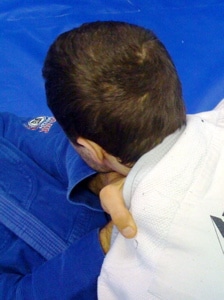 |
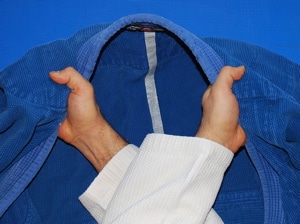 |
Take a look at how far apart my thumbs are in these two photos. Both hands have very shallow grips on the gi lapels. This means that the noose is still loose.
If you end up with this type of hand position DON’T blow out your grip by pulling on his lapels with a death grip in a doomed attempt to finish the choke. Try to sneak one hand (usually the bottom hand) deeper, into a better position. Depending on the exact choke, sometimes it’s also possible to tighten things up by bringing your legs into play and/or rotating your body.
Just to clarify, there are two basic ways to do the cross collar choke. Let’s assume that your right hand is already deep in his collar. Your second (left) hand can either go: A) under your right arm and grip the lapel palm up, or B) over your right arm and grip either the lapel or shoulder palm down. Both methods rely on having the first hand in deep, just like we’ve talked about today.
A BETTER Way: One Hand Deep
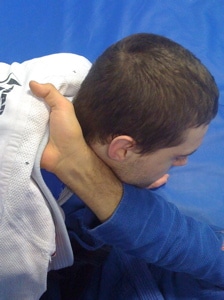 |
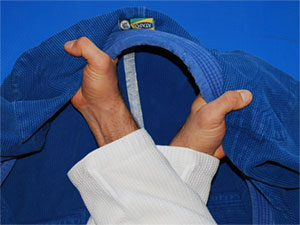 |
Sometimes you can only get one hand deep into his collar. That’s OK – because you only need one deep grip for your opponent to be in a lot of trouble!
When I’m trying to get this initial grip my goal is to grab the gi material right at the back of his neck (see my right hand in the first photo above). If my hand gets anywhere near here then the sharp parts of my wrist and forearm are right on my opponent’s neck, ready to cut off the circulation on that side.
Now I just have to take some of the slack out of the system with my other hand (by pulling on the other lapel) and the choke is on. In the second photo you can see how the noose is tighter than in the previous example.
My Brazilian Jiu-Jitsu coach Marcus Soares always says that if he can get even one of his hands is deep in the collar then he KNOWS he can finish the choke!
The BEST Way: Both Hands Deep
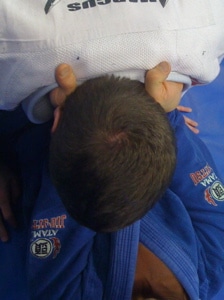 |
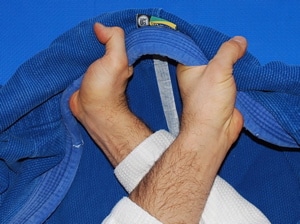 |
Now you’ve got your first AND your second hand in super deep – things are looking bleak for your opponent. If you pull his head down to your chest he’s going to tap out for sure!
As you can see in the above photos, my hands are almost touching. This makes the noose very small, very tight and very effective. You can’t always get to this exact hand position, but it’s a goal to strive for whenever you’re trying to tap out your opponent with a gi choke.
The Take-Home Message…
By now it should be pretty obvious that deeper is better, and tight makes right. If both your grips are shallow, then it’s hard to finish a choke. If both grips are deep then your chances of finishing the choke are very good.
Just bring his head to your chest and flare out your elbows; he should tap out!
In this lesson I used the cross-collar choke from guard to talk about grips, but what we talked about applies in many different situations.
There are a ton of fancy chokes that use your opponent’s gi. It doesn’t matter if you’re attacking with a cross collar choke from mount, a sliding collar choke from rear mount, or a clock choke when your opponent turtles; they all work much better if you have at least one hand deep in the collar!
| Click here for more information about Stephan Kesting’s Grappling Tips Newsletter and downloading your 100% FREE digital copy of ‘A Roadmap for Brazilian Jiu-Jitsu (aka ‘How to Learn BJJ Fast)’ |  |
The post The Biggest Gi Choke Mistake (And How to Fix It) appeared first on Grapplearts.
